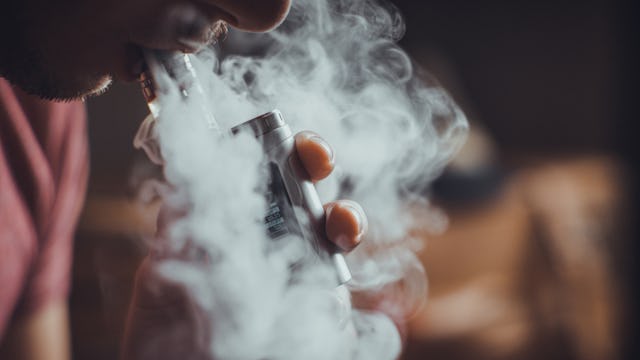Teens Who Use E-Cigarettes Are Exposed To Cancer-Causing Chemicals

Teens using e-cigarettes are exposed to cancer-causing chemicals
If your teen has an e-cigarette, then they’re being exposed to cancer-causing chemicals even if they’re not the kind with nicotine in them. A new study from researchers at the University of California San Francisco showed that teens who used e-cigarettes are inhaling potentially cancer-causing compounds.
The fight to get teens to not use e-cigarettes isn’t any easy one because manufacturers are marketing some e-cigarettes to kids, like Juul, and then making specific flavors just for them as well. But on top of that, there hasn’t been a ton of research done on how damaging they can be to kids with or without nicotine – until now. “Teenagers need to be warned that the vapor produced by e-cigarettes is not harmless water vapor, but actually contains some of the same toxic chemicals found in smoke from traditional cigarettes,” explained lead researcher Mark L. Rubinstein, MD, a professor of pediatrics at UCSF.
Rubinstein and his team’s research will be published in the scientific journal Pediatrics this month. To determine what chemicals teens are exposed to they tested the urine of 67 teens who smoke e-cigarettes only, 17 who use e-cigarettes and the old-fashioned kind of cigarettes, and 20 teens who don’t use either. Kids who used e-cigarettes showed levels of toxic organic compounds three times higher on average than the kids who didn’t smoke. And then the teens who use both cigarettes showed levels of toxic organic compounds three times higher on average than the kids who only use e-cigarettes. We can all probably agree we want our kids exposed to the least amount of cancer-causing chemicals as possible.
“E-cigarettes are marketed to adults who are trying to reduce or quit smoking as a safer alternative to cigarettes,” Rubinstein shared. “While they may be beneficial to adults as a form of harm reduction, kids should not be using them at all.” The American Lung Association explained why: “There is no government oversight of these products. Absent Food and Drug Administration regulation, there is no way for the public health and medical community or consumers to know what chemicals are contained in e-cigarettes or what the short- and long-term health implications might be.”
It’s worth noting again that Rubinstein and researchers found toxic chemicals in the kids who used nicotine-free flavored e-cigarettes including acrylonitrile, acrolein, propylene oxide, acrylamide, and crotonaldehyde. “Acrylonitrile is a highly poisonous compound used widely in the manufacture of plastics, adhesives and synthetic rubber,” according to the National Center for Biotechnology Information. None of the other chemicals are great for people either, which is why they’re considered toxic.
Rubinstein said it best: “Teenagers should be inhaling air, not products with toxins in them.”